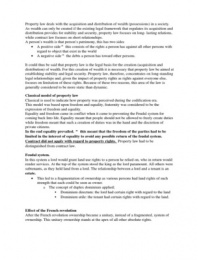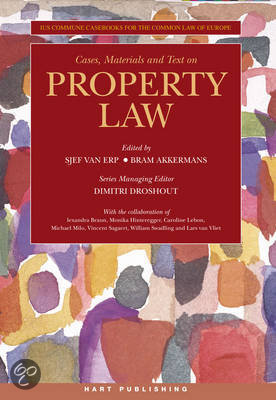Property law deals with the acquisition and distribution of wealth (possessions) in a society.
As wealth can only be created if the existing legal framework that regulates its acquisition and
distribution provides for stability and security, property law focuses on long- lasting relations,
while contract law focuses on short relationships.
A person’s wealth is that person’s patrimony, this has two sides
• A positive side this consists of the rights a person has against all other persons with
regard to object that exist in the world
• A negative side the debts a person has toward other persons.
It could thus be said that property law is the legal basis for the creation (acquisition and
distribution) of wealth. For this creation of wealth it is necessary that property law be aimed at
establishing stability and legal security. Property law, therefore, concentrates on long-standing
legal relationships and, given the impact of property rights as rights against everyone else,
focuses on limitation of these rights. Because of these two reasons, this area of the law is
generally considered to be more static than dynamic.
Classical model of property law
Classical is used to indicate how property was perceived during the codification era.
This model was based upon freedom and equality, fraternity was considered to be the
expression of freedom and equality.
Equality and freedom came in conflict when it came to preventing the Feudal system for
coming back Into life. Equality meant that people should not be allowed to freely create duties
while freedom meant that such a creation of duties was in the hand and the discretion of
private citizens.
In the end equality prevailed. this meant that the freedom of the parties had to be
limited in the interest of equality to avoid any possible return of the feudal system.
Contract did not apply with regard to property rights. Property law had to be
distinguished from contract law.
Feudal system.
In this system a lord would grant land use rights to a person he relied on, who in return would
render services. At the top of the system stood the king as the lord paramount. All others were
subtenants, as they held land from a lord. The relationship between a lord and a tenant is an
estate.
• This led to a fragmentation of ownership as various persons had land rights of such
strength that each could be seen as owner.
o The concept of duplex dominium applied;
Dominium directum: the lord had certain right with regard to the land
Dominium utile: the tenant had certain rights with regard to the land.
Effect of the French revolution
After the French revolution ownership became a unitary, instead of a fragmented, system of
ownership. This unitary ownership stands at the apex of all other absolute rights.
,Creation of property rights
In order to distinguish between property law and contract law, two principles were developed.
These principles are now known as the leading principles of the classical model of property
law and are:
• The numerus clausus principle: the number and content of property rights is limited
and the way they are created, transferred and extinguished is laid down in mandatory
format.
• Transparency principle:
o Publicity
o Specificity
Furthermore, several ground rules applied:
• Nemo dat: one cannot transfer that one does not have.
• Prior tempore: older rights take priority over newer rights.
• Limited rights take priority over fuller rights
• Property enjoys special protection
Subjects and objects of ownership.
The focus was on the citoyen; this is an individual citizen with immovable property that
allowed him to take part in commercial and political activities.
The classical model of property law focussed on corporael objects, not on claims and
intellectual property. Furthermore, the focus was not only on corporeal objects, but also
particularly on immovable property, especially land.
The common law and the classical model
• The common law is still, more in theory than in practice, rooted in the feudal system.
• Property concepts have not been derived from roman law.
• The idea of ownership as the most absolute right, at the apex of a system of property
rights, can also not be found in the common law.
However, the common law does apply all the abovementioned principles!
A possible return of the feudal system as it existed is no longer considered to be a realistic
fear. This paves the way towards a more flexible numerus clausus principle. Parties should be
given more freedom to shape to give shape to the property rights traditionally recognised and
under strict conditions they should be given more the freedom to create new property rights.
A critical analysis of the classical model
To a large extent the classical model of property law still is model that reasonably well
explains the fundamentals of the civil (and to some degree also the common) law of property.
There are several reasons for this. An important ground for the continued existence of the
model is caused by its strength and effectiveness. Property law deals with long-standing
relations. These long-standing relations are the legal foundations upon which economic wealth
can be built.
, • the classical model of property law proved to be a highly effective model
And traditionally only land was seen as an object of property law as it was the most valuable
at the time. This changed as a result of the industrial revolution. During that period movable
assets became of growing importance, together with claims on debtors. The main reason
behind this development was the need for secured financing: movables and claims represented
value that could secure the repayment of a loan.
,Much computer code is just one step removed from a pure idea. It is non-
rivalrous ; that is, one person’s use of the code does not stop another
person from using it. This kind of code is protected by the law of
intellectual property. Intellectual property protects the creative
interest in non-rivalrous resources.
There’s however also another code. This kind of code is designed to act
more like land or chattel than ideas. It pervades the internet and
comprises many of the most important online resources. Often this kind
of code makes up the structural components of the internet itself,
these sources are rivalrous codes. If one person owns and controls
them, others do not. They are persistent. They do not go away when you
turn your computer of and they are interconnected. Other people can
interact with them.
Virtual property tends to be governed by the law of intellectual property.
Holders of intellectual property rights have been systematically
eliminating emerging virtual property rights by the use of contract called
end user license agreements. Why is it important that we have a
theory of virtual property? The common law of property works to ensure
that resources are used well. If we do not have a good theory of virtual
property, then virtual property will be poorly used.
A theory of virtual property is critical to ensure efficient use of
internet resources, lower search costs, and reduce negotiation
costs that would otherwise prevent the flow of high-value
resources to high-value uses.
a good theory of virtual property is also important to the future of the
internet. If we protect virtual property, the internet could become a three-
dimensional global virtual environment.
What is virtual property?1
Virtual property shares three legally relevant characteristics with real
world property: rivalrousness, persistence, and interconnectivity.
• Rivalrousness in the physical world lets the owner exclude other
people from using owned objects. We often desire that power to
extend to cyberspace too and therefore it is designed into the code.
By design, we make code that can only be possessed by one
person. Thus rivalrousness exists also in code. if one person
controls rivalrous code, nobody else does.
• Persistence; There are other characteristics drawn from the physical
world that are incorporated into code as well. Objects and places in
the physical world are persistent. Code if often made persistent, that
1 See page 11/12 for examples American Soldier example!!
, is, it does not fade after each use and it does not run on one single
computer.
• Interconnectivity; objects in the real world are also naturally
interconnected. Two people in the same room experience exactly the
same objects. Objects in the real world can affect each other, by the
law of physics. Similarly, code can be made interconnected, so that
although on person may control it, others may experience it.
Virtual property related to bank-transactions
Virtual property also plays an important part in financial institutions – a
bank account may be one of the earliest forms of virtual property.41 Bank
accounts exist as loci within an interconnected network. The owner of an
account has an exclusionary right over a nexus of electronic credits and
debits located at that nexus. The bank account is persistent - even though
the account balance is merely an entry, that entry remains in the bank if
undisturbed. The bank account is interconnected - other people can send
money to the account, and the owner of the account can authorize money
to flow to other accountholders.
even where property is rivalrous (i.e., one person's use excludes
another's), there is no lessening of the overall ability for the next person to
obtain "enough and asgood. Other people can simply seek more of the
same type of property. If one internet address is already registered,
another is available. If one email address is taken, another can be
invented.
Anticommons
An anticommons is a state in which overlapping rights of exclusion cause
property to go unused or underused.
Digital enclosure
The basic story of the digital enclosure literature is one of information
enclosure. The digital enclosure literature argues that protecting websites
with passwords reduces the amount of information available to the rest of
us, and that as a result, such protection is undesirable. There is a fairness
ethic at work: if a person benefits from the broad readership the internet
provides, but does not contribute his own information to the information
commons, he is supposedly wrongfully enclosing his information to the
detriment of everyone. Since the internet benefits from network effects
(the more people who contribute the more valuable it is), any withholding
of information supposedly deprives everyone else of value. However, the
digital enclosure literature fails in its effort to describe an information






